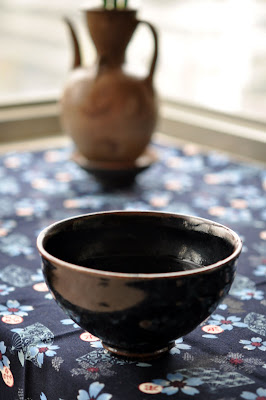 A kind reader sent me a sample of a 'mid 1960s sheng loose puerh'. Such an old puerh is supposed to taste divine. After a rinse and 2 brews, it didn't feel clean and smooth in the mouth and along the throat. I decided to stop brewing it and switch to my early 1970s raw loose puerh. The dry leaves and the smell are very similar. The big difference between these 2 teas are the wet leaves. After 2 brews, I fished out some from the teapot for comparison. See Above. Can you guess which is really sheng?
A kind reader sent me a sample of a 'mid 1960s sheng loose puerh'. Such an old puerh is supposed to taste divine. After a rinse and 2 brews, it didn't feel clean and smooth in the mouth and along the throat. I decided to stop brewing it and switch to my early 1970s raw loose puerh. The dry leaves and the smell are very similar. The big difference between these 2 teas are the wet leaves. After 2 brews, I fished out some from the teapot for comparison. See Above. Can you guess which is really sheng?The mouthfeel of my early 1970s is completely comfortable and, 3 hours after drinking it, I can still feel the sweet and powerful aftertaste.

 Yesterday's Cha Xi is also a good fit for my zhuni teapot and qinghua porcelain. The zhuni and the brew bring a warm touch to a sea of blue.
Yesterday's Cha Xi is also a good fit for my zhuni teapot and qinghua porcelain. The zhuni and the brew bring a warm touch to a sea of blue.Now that the tea in my tea cup feels right and delicious, I can switch my mindset from critical and investigative to happy and thankful. With tea pleasure, my mind is set free and can enjoy all aspects of my Cha Xi.
For instance, I can enjoy the peaceful harmony of this black glazed bowl made by hand by my friend Michel.
Update: On the subject of the color of the spent leaves, I have received several comments and e-mails. Let me summarize and add some important points:
- The black leaves on the right are typical of shu puerh ; however, not all shu puerh is as black. Sometimes, the wo dui process is shorter or lighter and doesn't result in such a level of dark color.
- The sheng leaves on the left show leaves with varying colors and darkness. The leaves and stems with most moisture will turn darkest over time (in the humid climate of Asia). Seeing a portion of black leaves is normal and doesn't necessarily mean it's a mix of sheng and shu. (A pure taste will say if it's a mix or not).
- 30 years ago, the manufacturers would have recipes and use different grades, different kinds of leaves in their production. That's why it is normal to see very diverse leaves. Having very similar leaves is a modern trend.










































